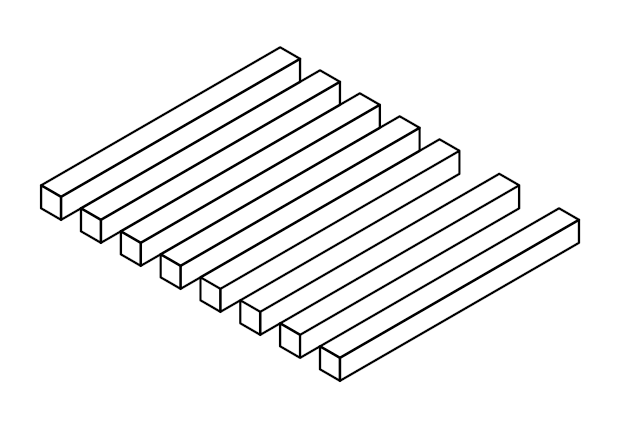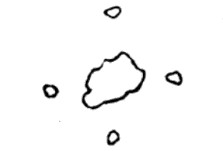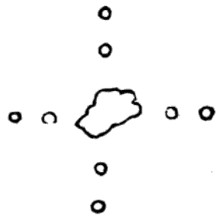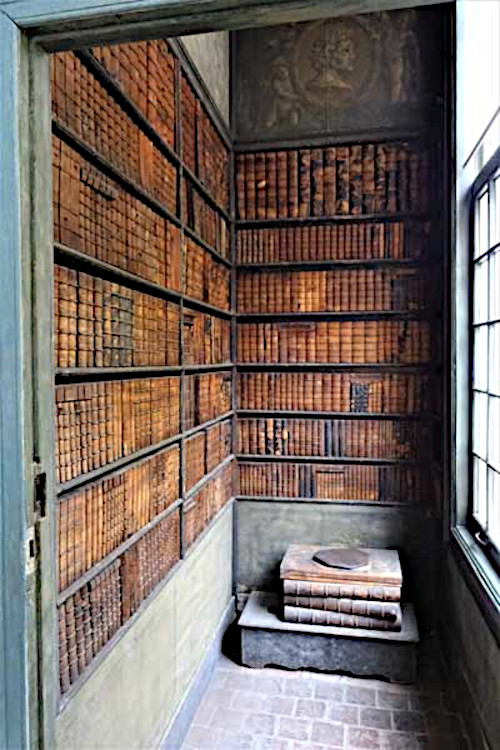
By Nevit Dilmen. How many sticks do you see?

By Nevit Dilmen. How many sticks do you see?
Memorable excerpts from the detective fiction of Michael Avallone (1924-1999):
This and my recent post on Robert Leslie Bellem were inspired by Bill Pronzini, who has written two appreciations of rapturously bad mystery fiction.
Drive east along the shore of Lake Erie toward the town of Port Colborne, Ontario, and the mill before you appears to shrink, rather than grow, as you approach.
Similar: The Rowes Wharf Arch Anomaly:
See The Vista Paradox.
“Suppose there was a pond, around which four poor men built their houses, thus:”

“Suppose four evil-disposed rich men afterwards built houses around the poor people, thus:”

“… and wished to have all the water of the pond to themselves. How could they build a high wall, so as to shut out the poor people from the pond?”

By Robert William Petrick, a perfectly requited sentiment.
Notable allusions to unrecorded cases of Sherlock Holmes:
Each of the first 18 multiples of 526315789473684210 contains all 10 digits:
526315789473684210 x 1 = 526315789473684210 526315789473684210 x 2 = 1052631578947368420 526315789473684210 x 3 = 1578947368421052630 526315789473684210 x 4 = 2105263157894736840 526315789473684210 x 5 = 2631578947368421050 526315789473684210 x 6 = 3157894736842105260 526315789473684210 x 7 = 3684210526315789470 526315789473684210 x 8 = 4210526315789473680 526315789473684210 x 9 = 4736842105263157890 526315789473684210 x 10 = 5263157894736842100 526315789473684210 x 11 = 5789473684210526310 526315789473684210 x 12 = 6315789473684210520 526315789473684210 x 13 = 6842105263157894730 526315789473684210 x 14 = 7368421052631578940 526315789473684210 x 15 = 7894736842105263150 526315789473684210 x 16 = 8421052631578947360 526315789473684210 x 17 = 8947368421052631570 526315789473684210 x 18 = 9473684210526315780
The 19th multiple, alas, is 9999999999999999990.

In 1772, wool merchant François Adrien Van den Bogaert commissioned a garden pavilion for Den Wolsack, his house in Antwerp. On the first floor is a bibliophile’s lavatory, in which the bowl is concealed in a fancifully rendered stack of books.
The volumes on the surrounding shelves aren’t real; they’re made of wood covered with leather.
(Thanks, Serge.)

At midday each June 21, a shaft of light pierces the roof of a mausoleum in Brussels’ Laeken Cemetery and creates a heart of light.
It’s not clear whether this was deliberate. The tomb’s occupants, Louise Flignot and Léonce Evrard, died in 1916 and 1919, and the mausoleum was not built until 1920. Its designer, one Georges deLarabrie, is not known to have produced any other work, and the planning documents don’t mention the heart.
When Sir Lawrence Tanfield died in 1625, his wife composed this inscription for their joint monument at Burford in Oxfordshire:
Here shadows lie
Whilst earth is sadd,
Still hopes to die
To him she hadd.
In bliss is hee
Whom I loved best;
Thrice happy shee
With him to rest.
So shall I bee
With him I loved,
And he with mee
And both us blessed.
Love made me poet,
And this I writt;
My heart did do it,
And not my wit.
See Workaround, Reunion, and Early Arrival.
In 1988, traversing synonyms in the Merriam-Webster Collegiate Dictionary, A. Ross Eckler found his way from TRUE to FALSE:
TRUE-JUST-FAIR-BEAUTIFUL-PRETTY-ARTFUL-ARTIFICIAL-SHAM-FALSE
He found his way back again by a different route:
FALSE-UNWISE-FOOLISH-SIMPLE-UNCONDITIONAL-ABSOLUTE-POSITIVE-REAL-GENUINE-TRUE
He was using the dictionary’s ninth edition; see the article below for his conventions regarding qualifying synonyms. Two more examples:
BAD-POOR-MEAN-PENURIOUS-STINGY-CLOSE-SECRET-FURTIVE-SLY-CUNNING-CLEVER-GOOD
GOOD-CLEVER-CUNNING-SLY-FURTIVE-SECRET-TICKLISH-CRITICAL-ACUTE-SHARP-HARSH-ROUGH-INDELICATE-INDECOROUS-IMPROPER-INCORRECT-WRONG-SINFUL-WICKED-EVIL-BAD
LIGHT-BRIGHT-CLEVER-CUNNING-SLY-FURTIVE-SECRET-HIDDEN-OBSCURE-DARK
DARK-OBSCURE-VAGUE-VACANT-EMPTY-FOOLISH-SIMPLE-EASY-LIGHT
Somewhat related: Lewis Carroll invented word ladders, in which one transforms one word into another by changing one letter at a time:
COLD-CORD-WORD-WARD-WARM
Each intermediate step must itself be an English word. Donald Knuth once used a computer to find links among 5,757 common five-letter English words. 671 of these, he found, were not connected to any other word in the collection. These he dubbed “aloof” — and noted that ALOOF itself is such a word.
(A. Ross Eckler, “Websterian Synonym Chains,” Word Ways 21:2 [May 1988], 100-101.)